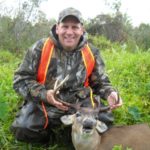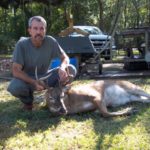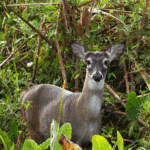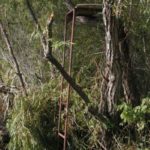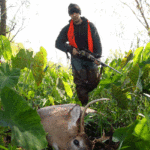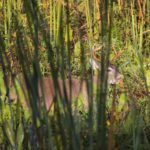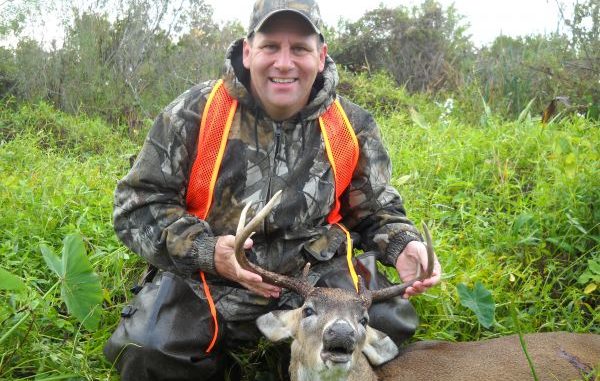
Marsh hunting is a step outside of the norm, with the tangle of vegetation making it easy for deer to disappear. Here are some tips to up your odds.
The suspicious speck of white flickered some 200 yards away, resembling what might have been simply a bird flying or the cotton-like puff from the head of a cattail bursting its contents in the wind.
But, when hunting deer in the marsh, nothing is left to chance — where coastal deer are concerned, more often than not it’s simply “now you see em, now you don’t.”
The suspicious white-colored flicker needed to be thoroughly checked out, and not simply become a passing thought that would leave me wondering on the boat ride to the landing.
Picking up my binoculars, I studied the white speck. It was still moving and, low and behold, the white turned out to be a deer’s ear.
Closer inspection revealed its nose, then eye and, before too long, the full head of a doe. She was bedded down in a cowpea patch with her food source inches from her muzzle.
Talk about eating in bed. This deer was growing butterball fat on legumes and not wasting energy she’d need to reproduce and carry next year’s offspring in her belly over the winter.
The whole experience left me knowing that marsh tactics, similar to those used in other regions of the country, require a higher degree of perseverance. Over the years, I’ve learned that not studying those white specks and simply blowing them off possibly means missing out on a buck of a lifetime.
That’s exactly how Phil Dugas has found success in the marshes of Louisiana’s coast.
“I do a whole lot of glassing, and I stay in the binoculars,” said Centerville’s Dugas, who hunts the coastal marsh near East Cote Blanche Bay in St. Mary Parish. “When I get out of the stand after a two or three hour hunt, my eyes burn so bad.
“But, I’ll see a lot of deer. And a lot of them may be small bucks and does that there is no way I’d shoot.”
He’s pretty selective in what he shoots, but he can only find them if he has the right equipment.
“It has got to be nice if I’m going to shoot way out there, where I’ve had to glass,” Dugas said. “But, I never go to the stand without a pair of binoculars.
“It’s about paying attention and doing a lot of glassing.”
The day before, a string of text messages my son sent me while sitting on the same stand I was now watching the doe from revealed how boredom can get the best of you. But, it can happen at any instance in the marsh – even while texting one another, where I killed and he was in the first throws of giving up.
Son: “Dad, see anything?”
Me: “No but it’s early.”
Son: “I haven’t seen anything.”
Me: “That’s a good stand, you should.”
Son: “K.”
Me: “I see some deer in the grass.”
The report from my H&R Handi-Rifle chambered in a .444 Marlinr that I use for primitive weapon season echoed across the marsh; seconds later my cell phone vibrated on my hip.
Son: “You get him?”
Me: “Yeah, coming to get you to help.”
My son hadn’t seen anything the first couple hours of our hunt together, but it didn’t mean they weren’t there. The day before, I had placed him on one of our best stands overlooking the pea patch, where I was looking at the bedded down doe.
The stand had produced year after year. What’s more, there was an abundance of fresh sign along the canal bank where it was positioned overlooking the marsh.
Point of fact: You have to be looking, and looking hard. I was convinced deer were there when my son sat in the stand, and I can’t say he wasn’t paying attention. But he simply might not have been looking for the right things.
When hunting the marsh it’s about the little details, Dugas said.
“One thing I do in particular, when I’m in the stand is I look for things that are on a horizontal plane,” he explained. “I tell that to all young hunters that I take. I tell them, ‘Look for horizontal planes because most everything out there that you’re going to see is vertical.’
“What you look at may turn out to be a log or a low tree branch, but more often than you think it will turn out to be a deer you can shoot.”
To make a point when explaining how to hunt deer in the marsh, I’ve often asked people how tall is a deer at the shoulder. Invariably, most place their hand about chest high, and I say, “Really? A deer is four and a half feet high at the shoulder?”
The truth is that the most-healthy, fully mature whitetail deer are no more than 36 to 42 inches high at the shoulder, with the very biggest being 42.
Place an animal that size in the marsh, where bull tongue is waist high, flag grass is 8 feet high, roseau cane is 10 feet high and other plants like cord grass, arrow weed, and a variety of rush grasses are thick and there is more than enough vegetation to hide an elephant let alone a whitetail.
Knowing a deer’s size means to look and think smaller in a marsh’s vastness, Dugas said.
“When I first started hunting the marsh I hated it because of the grass,” he said. “I’d get down from my stand, and the grass was up to my chest and sometimes up to my eyes.
“When I saw a deer I was scared to shoot it; I thought they were too small.”
Color is also an important detail that bears mentioning. Marsh deer tend to have two prominent colors – a sort of reddish-brown and a grayish-brown. Both, when hidden in the shadows of flag grass cause whitetails to disappear.
Even if a buck is bedded and has his nose in the air, with only his rack visible, his antlers are often the color of flag grass and blend in perfectly. Like shape-shifting aliens from another planet, marsh whitetail sort of become the plants that surround them – now you seem em, now you don’t.
Stand preparation because of the high foliage conditions typically follows two schools of thought: creating wide shooting lanes, or leaving it natural and taking your chances.
It helps to cut roads like you’d find when hunting over a pipeline right-of-way in the uplands. Unfortunately, this isn’t accomplished in the marsh using a bush hog. More often than not, you’re stuck with using a cane knife to do the job, unless you’re lucky enough to be able to use airboats to flatten a road in the flag grass.
But lots of deer are harvested in roads cut in the marsh: They follow paths of least resistance, and it is an effective tactic, when all is said and done.
However, be aware that not all land companies or public land rules and regulations allow this. It’s important to check with land and wildlife managers to find out what applies to your situation.
For his part, Dugas prefers leaving the surroundings he prepares around his stands more natural, and also prepping closer to opening day of the Area 7 deer season he hunts.
“I’ll choose a stand location, where when I get up into it I can actually see the deer trails where deer are coming out of thick stands of myrtle trees and pea patches,” said Dugas, who explained that he hunts 20 feet in the air. “I don’t cut shooting lanes: The only lane I have is the one I make when I take the panels out to my stand.”
But he does all he can to make this trail wide enough for him to catch deer.
“I never walk the same trail – I move over,” Dugas said. “By the time you’re finished you’ll have a 6-foot wide back trail to the stand.
“And, I have watched, seen and killed deer walking in my back trail. Maybe it’s the lazy man’s approach, but I’m leery about messing up the natural habitat of deer.”
Other than that, however, he tried to leave the area as undisturbed as possible.
“I also prep later, because I’ve seen where guys have made a lot of racket or run airboats to break roads and deer have moved out,” Dugas said. “I use cordless drills, and try and be as quiet as possible leaving the surroundings as natural as possible.”
Understanding when the rut takes place in the marsh is when hunters become really successful along the coast. During the rut, bucks literally throw caution to the wind and show themselves more.
The problem is that when the rut takes place along the coast in regions like Area 7 it’s also the hottest part of fall. Quite often the rut takes place when it’s 80 degrees during the day and, though the nights are cooler with temperatures in the low to mid 60s, hunters often avoid being out in temperatures where mosquitoes will carry you off or force a blood transfusion.
Nonetheless, the peak rut in the coastal marsh differs from elsewhere in the state.
That peak typically takes place between the second and third weeks of October.
By late September, coastal marsh deer hunters can find rub lines, as well as scrapes and in an increase in activity recorded on trail cameras, along canal banks.
Many would argue that the rut takes place later in the marsh, but fetus studies conducted by the Louisiana Department of Wildlife & Fisheries prove otherwise.
St. Mary Parish is one coastal region where the parish falls into Areas 6 and 7.
“You’ve got some different things happen down along the coast, particularly in St. Mary Parish,” LDWF Deer Study Leader Scott Durham said. “You have some converging ruts. You have some early rut in the marsh and some later rut happening, like on Attakapas WMA.
“Though we haven’t done any studies there in awhile, fetal studies show breeding occurring in October along the coast.”
Going coastal means taking advantage of the most-active rutting periods regardless of heat and mosquitoes. Again, it’s then when they are most vulnerable and less hidden in the tall grasses of the marsh and surrounding green habitat.
According to Durham, primitive weapon seasons are set to allow hunters to take advantage of some of that pre-rut activity.
Primitive weapon season for Areas 3, 7 and 8 all open on Oct. 13 and is followed a week later by the regular gun season.
When heavy, rut-stricken buck movement occurs in the marsh, fixed stands overlooking patches of cowpeas or other food in the marsh often become less productive.
In such cases, becoming mobile can increase chances of success. Here is where a lightweight lean-to style deer stand can become invaluable.
Though the marsh is not nearly as heavy in mast production in the form of acorns, wild pecans and hickory nuts as the northern regions of the state, canal banks do have live and water oaks.
Typically, in early October it’s not uncommon to find beaten-down deer trails leading from the marsh to these trees those producing a few acorns. Here is where being mobile is effective.
Moving your lean-to into position often increases your chances to score a buck or a doe, as deer will leave the cowpeas for the irresistible acorns as long as they are available.
Going coastal doesn’t always mean you’ll harvest a deer as often or big as those found in the bottomland hardwoods of the northern regions of the state. It also might mean hoards of mosquitoes may cause you to need a blood transfusion from hunting in hot weather.
But one thing is for certain: If you’re going coastal in October to hunt marsh whitetails, employing some of these basic tactics and understanding the early rut will improve your chances of scoring.
Otherwise, you may be stuck with, “now you see em, now you don’t!”
